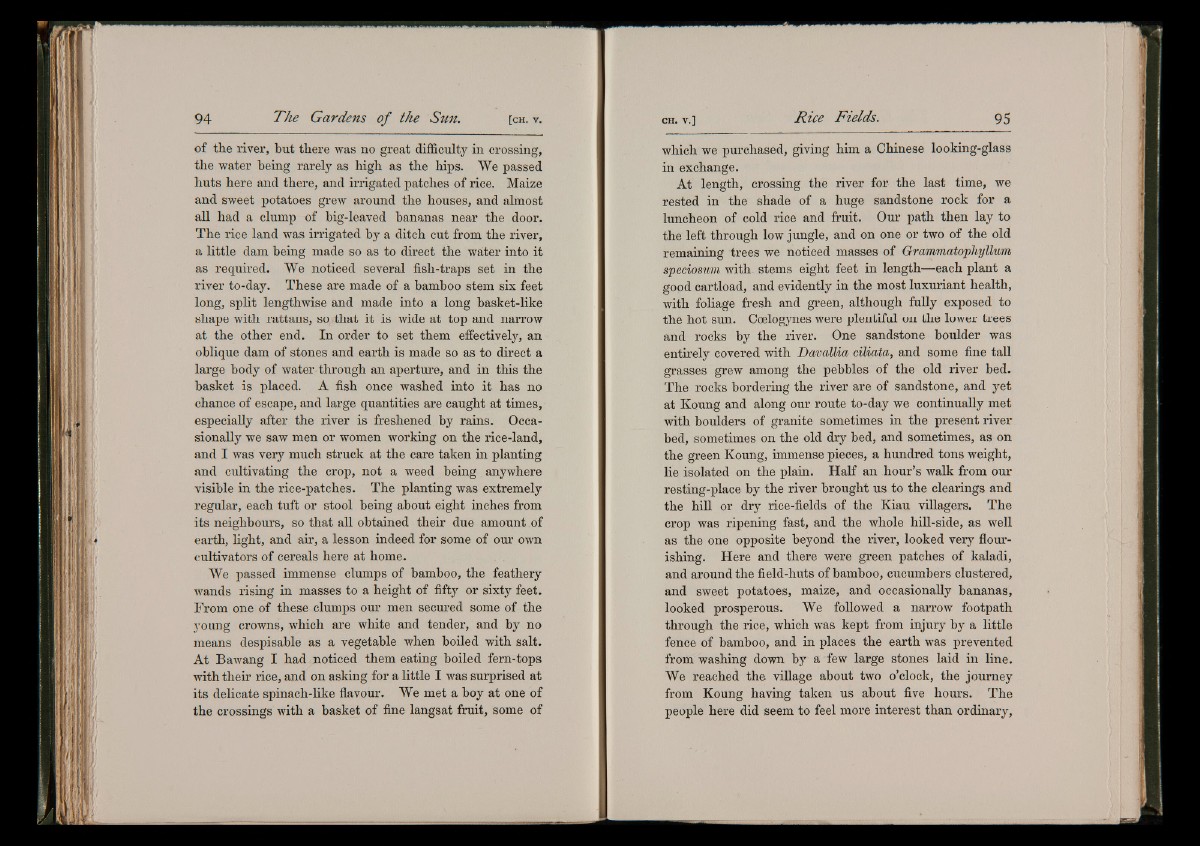
of the river, hut there was no great difficulty in crossing,
the water being rarely as high as the hips. We passed
huts here and there, and irrigated patches of rice. Maize
and sweet potatoes grew around the houses, and almost
all had a clump of big-leaved bananas near the door.
The rice land was irrigated by a ditch cut from the river,
a little dam being made so as to direct the water into it
as required. We noticed several fish-traps set in the
river to-day. These are made of a bamboo stem six feet
long, split lengthwise and made into a long basket-like
shape with rattans, so that it is wide at top and narrow
at the other end. In order to set them effectively, an
oblique dam of stones and earth is made so as to direct a
large body of water through an aperture, and in this the
basket is placed. A fish once washed into it has no
chance of escape, and large quantities are caught at times,
especially after the river is freshened by rains. Occasionally
we saw men or women working on the rice-land,
and I was very much struck at the care taken in planting
and cultivating the crop, not a weed being anywhere
visible in the rice-patches. The planting was extremely
regular, each tuft or stool being about eight inches from
its neighbours, so that all obtained their due amount of
earth, light, and air, a lesson indeed for some of our own
cultivators of cereals here at home.
We passed immense clumps of bamboo, the feathery
wands rising in masses to a height of fifty or sixty feet.
From one of these clumps our men secured some of the
young crowns, which are white and tender, and by no
means despisable as a vegetable when boiled with salt.
At Bawang I had noticed them eating boiled fern-tops
with their rice, and on asking for a little I was surprised at
its delicate spinach-like flavour. We met a boy at one of
the crossings with a basket of fine langsat fruit, some of
which we purchased, giving him a Chinese looking-glass
in exchange.
At length, crossing the river for the last time, we
rested in the shade of a huge sandstone rock for a
luncheon of cold rice and fruit. Our path then lay to
the left through low jungle, and on one or two of the old
remaining trees we noticed masses of Grammatophyllum
speciosum with, stems eight feet in length—each plant a
good cartload, and evidently in the most luxuriant health,
with foliage fresh and green, although fully exposed to
the hot sun. Coelogynes were plentiful on the lower trees
and rocks by the river. One sandstone boulder was
entirely covered with Davallia ciliata, and some fine tall
grasses grew among the pebbles of the old river bed.
The rocks bordering the river are of sandstone, and yet
at Koung and along our route to-day we continually met
with boulders of granite sometimes in the present river
bed, sometimes on the old dry bed, and sometimes, as on
the green Koung, immense pieces, a hundred tons weight,
lie isolated on the plain. Half an hour’s walk from our
resting-place by the river brought us to the clearings and
the hill or dry rice-fields of the Kiau villagers. The
crop was ripening fast, and the whole hill-side, as well
as the one opposite beyond the river, looked very flourishing.
Here and there were green patches of kaladi,
and around the field-huts of bamboo, cucumbers clustered,
and sweet potatoes, maize, and occasionally bananas,
looked prosperous. We followed a narrow footpath
through the rice, which was kept from injury by a little
fence of bamboo, and in places the earth was prevented
from washing down by a few large stones laid in line.
We reached the village about two o’clock, the journey
from Koung having taken us about five hours. The
people here did seem to feel more interest than ordinary,